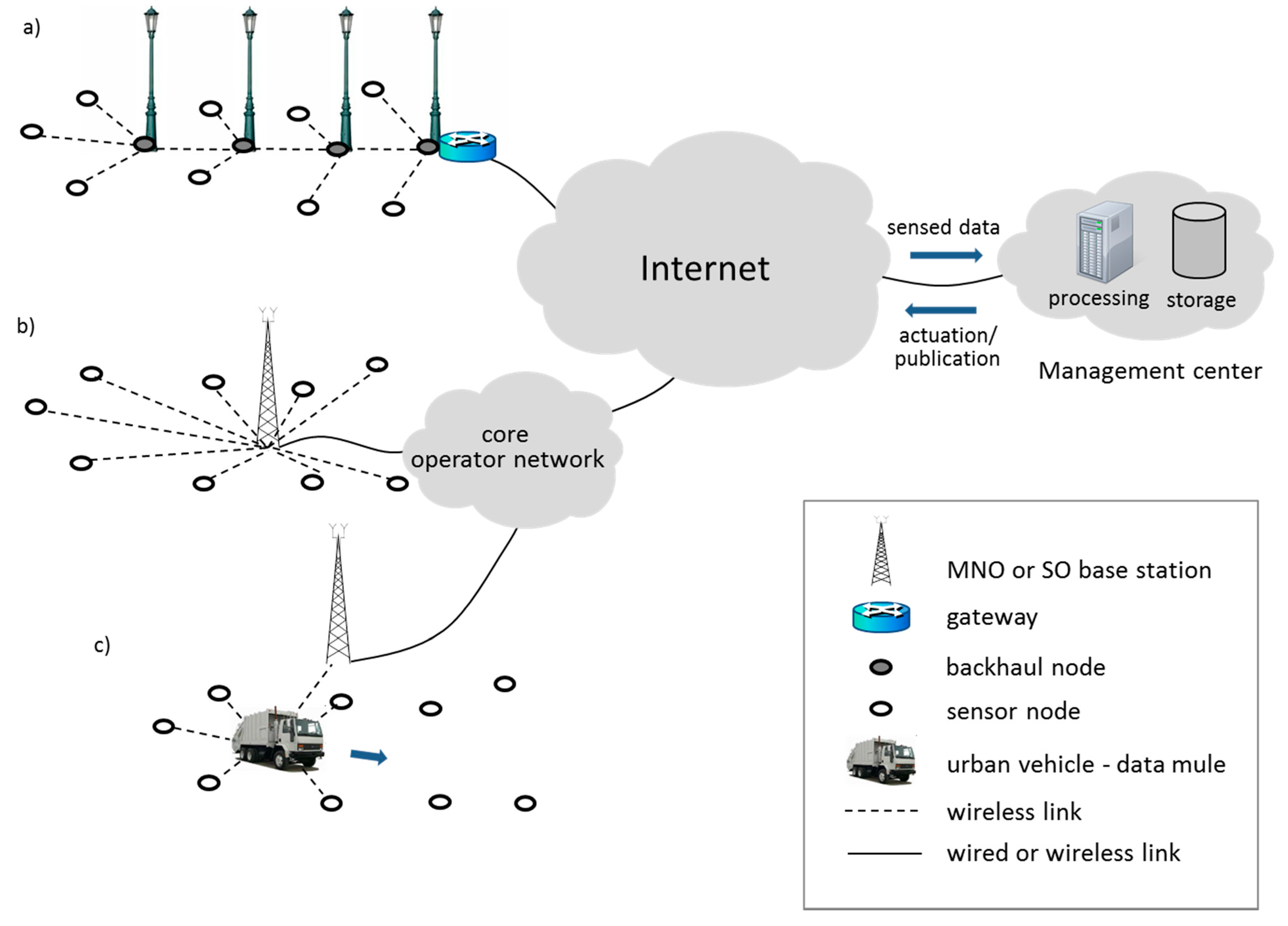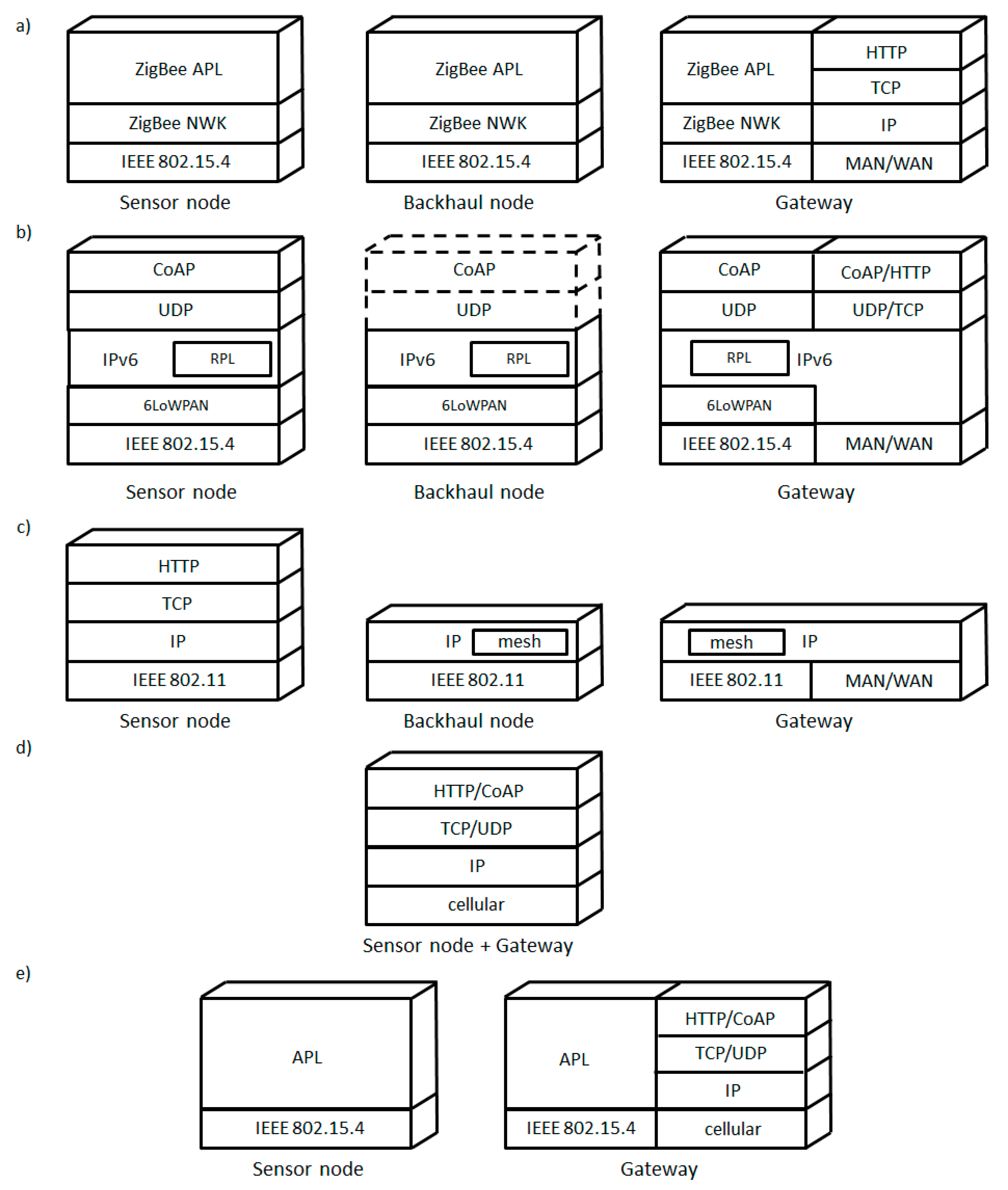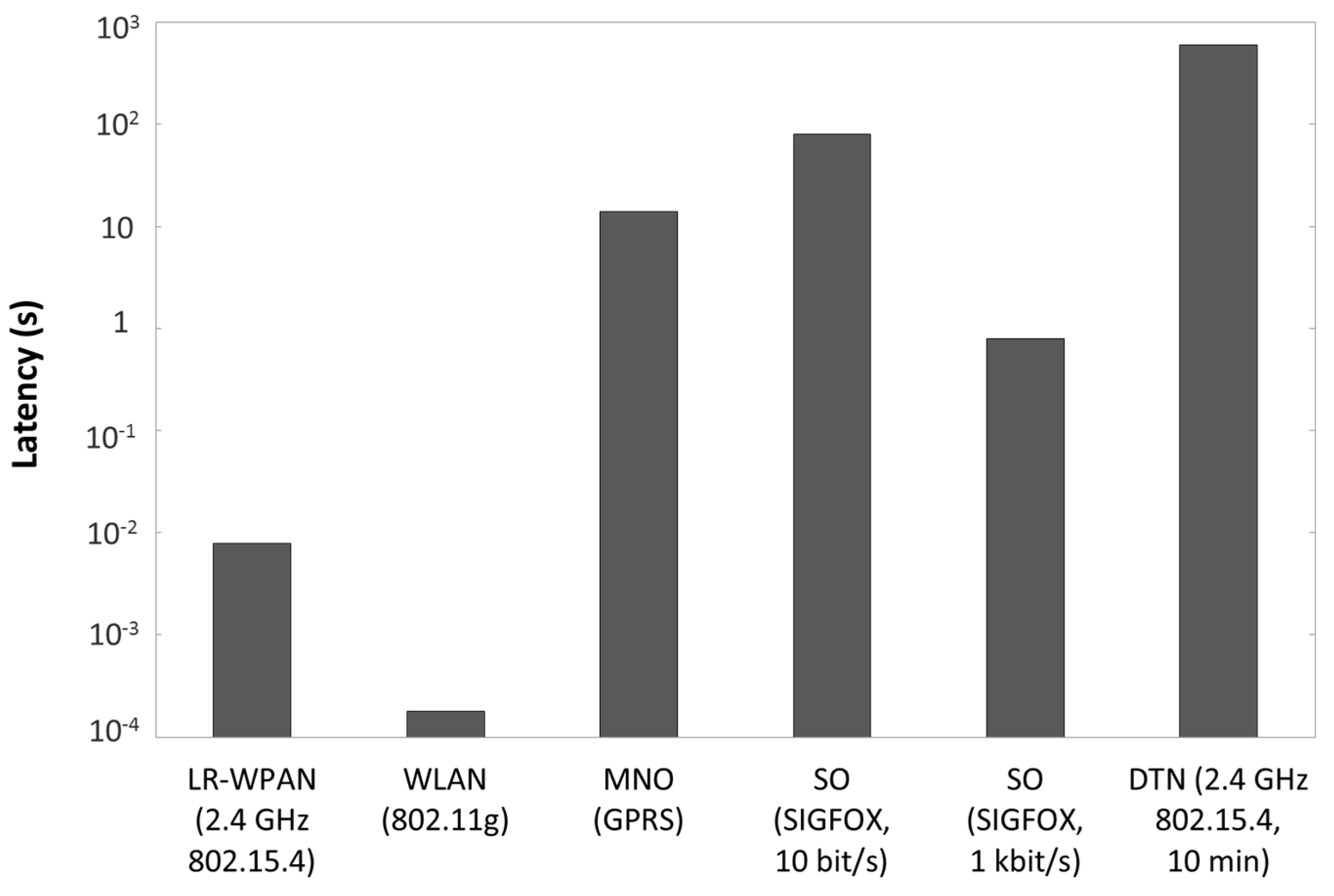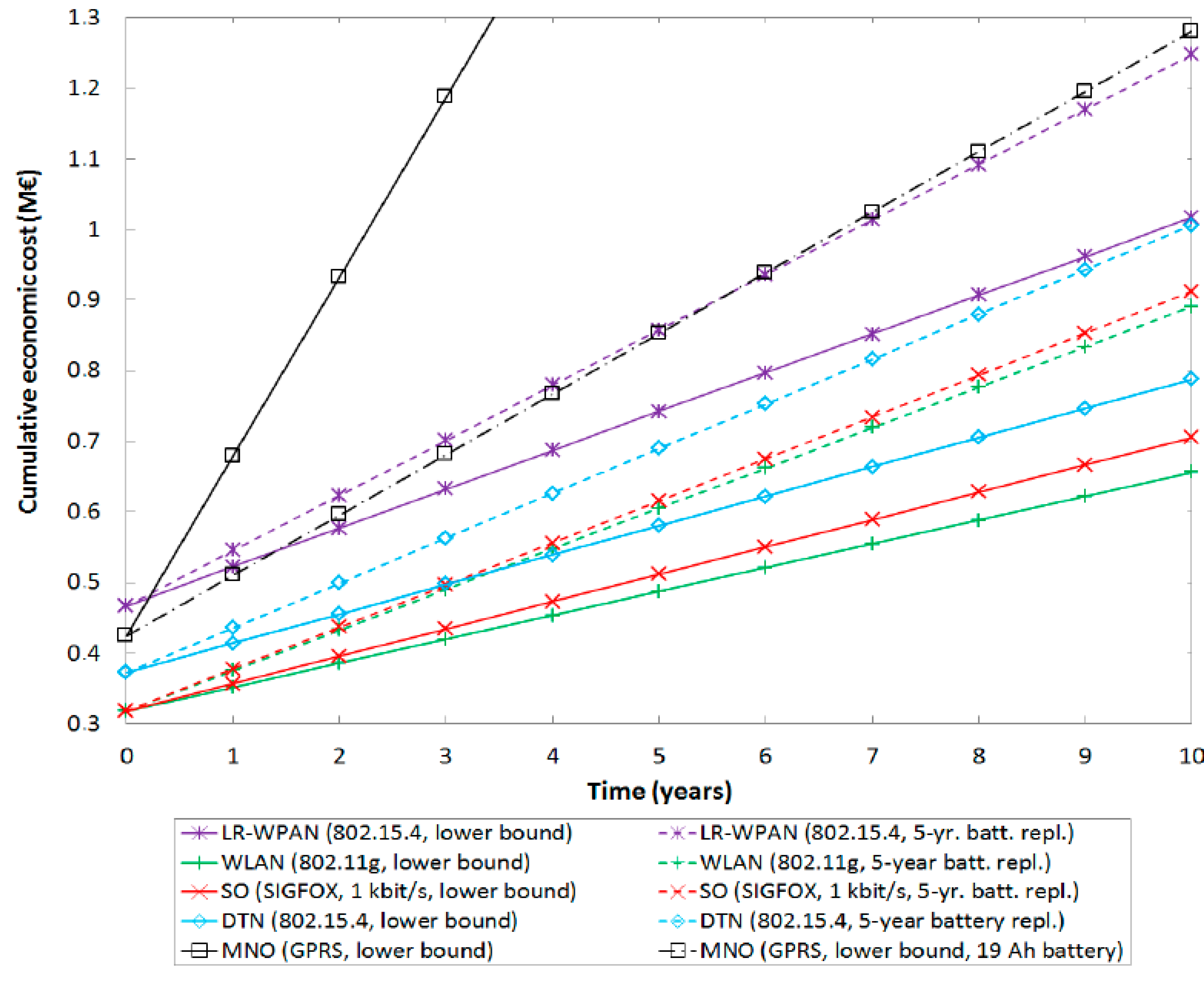Urban Automation Networks: Current and Emerging Solutions for Sensed Data Collection and Actuation in Smart Cities
Abstract
:1. Introduction
2. UAN Use Cases and Requirements
- Garbage collection. Garbage containers can be provided with sensors that measure the containers’ occupancy. This information can be used to ensure compliance with recommendations on waste management, and to optimize garbage truck routes.
- Lighting control. Street light control can be automated based on measurements carried out by light sensors. Furthermore, street light intensity levels can be tuned based on the presence of people or vehicles, which can be detected by using presence sensors.
- Green zone management. Efficient and automated water irrigation systems can be applied in green zones by exploiting humidity sensors placed in the ground.
- Environmental control. Sensors can be used to monitor physical magnitudes relevant to the citizens’ and environmental health, such as weather conditions, air composition, acoustic pollution and ultraviolet solar radiation, among others.
- Parking availability. Several types of sensors (such as pressure, ultrasound or magnetic field sensors) may be used to identify empty parking spaces, which constitute a scarce resource in cities. The event of a parking space becoming available must be communicated quickly.
- Street traffic. Magnetic loops can be used for monitoring road traffic. The collected information can be published, in order to allow the citizens take suitable route decisions, avoid congested areas and minimize their contribution to air pollution. Furthermore, traffic lights may be intelligently controlled based on the current road traffic state.
- Utility infrastructure. Large equipment infrastructures from utility companies are deployed in the city, often underground, for providing gas, electricity, water, telecommunications and sewage services. Use of appropriate underground sensors can dramatically decrease failure detection times, help identify the location of breakdowns or leaks, and allow preventive maintenance.
- Security. Presence, proximity or even glass-break sensors may be used to detect or prevent intrusion into municipality areas (e.g., buildings, parks, etc.) during time periods in which access is not allowed.

| Event-Based Alerts | Notification Periodicity | Actuators Involved | Sensor Node Location Accuracy | |
|---|---|---|---|---|
| Garbage collection | No | 1 h–24 h | No | High |
| Lighting control | Yes (if presence sensors are used) | 30 min | Yes | Medium |
| Green zone management | No | 1 h–24 h | Yes | Medium |
| Environmental control | No | 1 h | No | Low |
| Parking availability | Yes | 5 min | No | High |
| Street traffic | No | 5 min | Yes (traffic light control and info. panels) | High/Medium |
| Utility infrastructure | Yes | 12 h | No | High |
| Security | Yes | 5 min | Yes (for alarm activation) | High/Medium |
3. UAN Generic Architecture
3.1. Sensor and Actuator Nodes
3.2. Backhaul
3.3. Gateway
4. UAN Classes
4.1. LR-WPAN UANs

4.2. WLAN UANs
4.3. MNO UANs

Emerging and Future MNO UANs
4.4. SO UANs
4.5. DTN UANs
5. Discussion
5.1. Deployment and Sensor Node Coverage
5.2. Sensor Node Power Consumption versus Notification Periodicity
| LR-WPAN (Figure 3a,b) | WLAN (Figure 3c) | MNO (Figure 3d) | SO | DTN (Figure 3e) | ||
|---|---|---|---|---|---|---|
| Backhaul and gateway | Backhaul expressly deployed | Yes | No | No | No | Yes (intermittent) |
| Gateway expressly deployed | Yes | No (deployed a priori) | Yes (the sensor node includes the gateway) | No (deployed by the SIMless operator) | Yes (in public vehicles) | |
| Can be extended/tuned by the municipality | Yes | Yes | No (only the mobile operator can) | No (only the SIMless operator can) | Limited to available public vehicles | |
| Power solution | Mains power or batteries connected to streetlights | Mains power | Batteries or energy harvesting (gateway and sensor node implemented in the same device). Mains power desirable | Mains power | Gateway connected to vehicle battery | |
| Network characteristics | Latency (from sensor node to gateway) | Milliseconds (per hop) | <Milliseconds (per hop) | Tens of seconds | Hundreds of milliseconds to tens of seconds | Minutes or hours |
| Latency (from gateway to sensor nodes) | Minutes (Duty cycle period) | Minutes (Duty cycle period) | Minutes or hours (Duty cycle period) | Minutes or hours (Duty cycle period) | Minutes or hours (Time between connectivity events) | |
| Permanent connectivity (sensor nodes point of view) | Yes | Yes | Yes | Yes | No | |
| Sensor node location degree of freedom supported by the UAN | High | Medium | Medium/High | Medium | Low | |
| Smart City application support | Event-based applications | Yes | Yes | Yes (latency has to be considered) | Yes (latency has to be considered) | No |
| Notification periodicity (based on sensor node power consumption) | >10 s | > 10 s | >1 h | ≥10 min (at 1 kbit/s) > 1 h (at 10 bit/s) | 1 h to 1 day (due to connectivity limitations) | |
| Additional services | No | Video, web access | Image transfer, web access | No | No | |
| Standardized communication protocols | Yes | Yes | Yes | No (in progress) | No | |


5.3. Latency and Event-Based Application Support
5.4. Communication Protocols Standardization Status
5.5. Economic Cost
| Sensor Nodes | Backhaul Nodes | Gateways | |||||||||
|---|---|---|---|---|---|---|---|---|---|---|---|
| Acq. Cost | Subsc. Fee | Battery Acq. ct. | Num-Ber | Acq. Cost | Instal. Cost | Num-Ber | Acq. Cost | Instal. Cost | Internet Fee | Elec. Fee | |
| LR-WPAN | 200 | - | 7 | 200 | 200 | 330 | 20 | 1000 | 1130 | 20 | 2.7/month |
| WLAN | 200 | - | 14 | (a) | (a) | (a) | - | - | - | - | - |
| MNO (GPRS) | 300 | 1/month | 20 | - | - | - | (b) | (b) | (b) | (b) | - |
| SO | 200 | 2/year (c) [36] | 14 | - | - | - | - | - | - | - | - |
| DTN | 250 | - | 7 | - | - | - | 1 | 800 | 500 | 10/month | - |

6. Mobile Sensing Networks in the Smart City
| UANs | MSNs | |
|---|---|---|
| Garbage collection | Yes | No |
| Lighting control | Yes | Yes |
| Green zone management | Yes | No |
| Environmental control | Yes | Yes |
| Parking availability | Yes | Yes |
| Street traffic | Yes | Yes |
| Utility infrastructure | Yes | No |
| Security | Yes | No |
6.1. Smartphone-Centric MSNs
6.2. Vehicle-Centric MSNs
7. Smart City Modeling: Related Work
8. Conclusions
Acknowledgments
Author Contributions
Conflicts of Interest
References
- UN-HABITAT. Cities and Climate Change: Global Report on Human Settlements, 2011; United Nations Human Settlements Programme (UN-Habitat): Washington, DC, USA, 2011. [Google Scholar]
- Taewoo, N.; Pardo, T.A. Smart city as urban innovation: Focusing on management, policy, and context. In Proceedings of the 5th International Conference on Theory and Practice of Electronic Governance, Tallinn, Estonia, 26–28 September 2011.
- Hernández-Muñoz, J.M.; Vercher, J.B.; Muñoz, L.; Galache, J.A.; Presser, M.; Gómez, L.A.H.; Pettersson, J. Smart cities at the forefront of the future internet. In The Future Internet; Springer: Berlin/Heidelberg, Germany, 2001; pp. 447–462. [Google Scholar]
- Dohler, M.; Watteyne, T.; Winter, T.; Barthel, D. Routing Requirements for Urban Low-Power and Lossy Networks (RFC 5548). Available online: https://tools.ietf.org/html/rfc5548 (accessed on 8 September 2015).
- Zanella, A.; Bui, N.; Castellani, A.P.; Vangelista, L.; Zorzi, M. Internet of things for smart cities. IEEE Internet Things J. 2014, 1, 22–32. [Google Scholar] [CrossRef]
- Hancke, G.P.; de Carvalho e Silva, B.; Hancke, G.P., Jr. The role of advanced sensing in smart cities. Sensors 2012, 12, 393–425. [Google Scholar] [CrossRef] [PubMed]
- Vilajosana, I.; Llosa, J.; Martinez, B.; Domingo-Prieto, M.; Angles, A.; Vilajosana, X. Bootstrapping smart cities through a self-sustainable model based on big data flows. IEEE Commun. Mag. 2013, 51, 128–134. [Google Scholar] [CrossRef]
- Gea, T.; Paradells, J.; Lamarca, M.; Roldan, D. Smart cities as an application of internet of things: Experiences and lessons learnt in Barcelona. In Proceedings of the IEEE Seventh International Conference on Innovative Mobile and Internet Services in Ubiquitous Computing (IMIS), Taichung, Taiwan, 3–5 July 2013; pp. 552–557.
- Ding, Y.; Zhang, W.; Miyaki, T.; Riedel, T.; Zhang, L.; Beigl, M. Smart Beijing: Correlation of urban electrical energy consumption with urban environmental sensing for optimizing distribution planning. In Proceedings of the First International Conference on Smart Grids, Green Communications and IT Energy-aware Technologies, Venice/Mestre, Italy, 22–27 May 2011; pp. 98–101.
- Gil-Castineira, F.; Costa-Montenegro, E.; Gonzalez-Castano, F.J.; Lopez-Bravo, C.; Ojala, T.; Bose, R. Experiences inside the Ubiquitous Oulu Smart City. IEEE Comput. 2011, 44, 48–55. [Google Scholar] [CrossRef]
- Sanchez, L.; Muñoz, L.; Galache, J.A.; Sotres, P.; Santana, J.R.; Gutierrez, V.; Pfisterer, D. SmartSantander: IoT experimentation over a smart city testbed. Comput. Netw. 2014, 61, 217–238. [Google Scholar] [CrossRef]
- Chourabi, H.; Nam, T.; Walker, S.; Gil-Garcia, J.R.; Mellouli, S.; Nahon, K.; Pardo, T.A.; Scholl, H.J. Understanding Smart Cities: An Integrative Framework. In Proceedings of the 45th Hawaii International Conference on System Sciences, Honolulu, HI, USA, 4–7 January 2012.
- Gottschalk, M.; Uslar, M. Supporting the Development of Smart Cities using a Use Case Methodology. In Proceedings of the AW4CITY 2015 Workshop, Florence, Italy, 18 May 2015; pp. 541–545.
- Washburn, D.; Sindhu, U.; Balaouras, S.; Dines, R.A.; Hayes, N.M.; Nelson, L.E. Helping CIOs Understand “Smart City” Initiatives: Defining the Smart City, Its Drivers, and the Role of the CIO. Available online: http://www-935.ibm.com/services/us/cio/pdf/forrester_help_cios_smart_city.pdf (accessed on 10 August 2015).
- Paradells, J.; Gomez, C.; Demirkol, I.; Oller, J.; Catalan, M. Infrastructureless smart cities. Use cases and performance. In Proceedings of the IEEE International Conference on Smart Communications in Network Technologies (SaCoNeT), Vilanova i la Geltrú, Spain, 18–20 June 2014.
- Barcelona Smart City. Available online: http://www.i2cat.net/en/projects/barcelona-smart-city (accessed on 10 August 2015).
- IEEE Standard for Local and Metropolitan Area Networks—Part 15.4: Low-Rate Wireless Personal Area Networks (LR-WPANs); IEEE Std 802.15.4-2011 (Revision of IEEE Std 802.15.4-2006); IEEE: New York, NY, USA, 2011; pp. 1–294.
- IEEE Standard for Local and Metropolitan Area Networks—Part 15.4: Low-Rate Wireless Personal Area Networks (LR-WPANs)—Amendment 1: MAC Sublayer; IEEE Std 802.15.4e-2012 (Amendment to IEEE Std 802.15.4-2011); IEEE: New York, NY, USA, 2012; pp. 1–209.
- IEEE Standard for Local and Metropolitan Area Networks—Part 15.4: Low-Rate Wireless Personal Area Networks (LR-WPANs)—Amendment 3: Physical Layer (PHY) Specifications for Low-Data-Rate, Wireless, Smart Metering Utility Networks; IEEE Std 802.15.4g-2012 (Amendment to IEEE Std 802.15.4-2011); IEEE: New York, NY, USA, 2012; pp. 1–236.
- ZigBee Standards Organization. ZigBee Specification, Document 053474r17; ZigBee Alliance: Davis, CA, USA, 2008. [Google Scholar]
- Shelby, Z.; Bormann, C. 6LoWPAN: The Wireless Embedded Internet; John Wiley & Sons Ltd.: Chichester, UK, 2009. [Google Scholar]
- Winter, T.; Thubert, P.; Clausen, T.; Hui, J.; Kelsey, R.; Levis, P.; Pister, K.; Struik, R.; Vasseur, J.P.; Alexander, R. RPL: IPv6 Routing Protocol for Low power and Lossy Networks (RFC 6550). Available online: https://tools.ietf.org/html/rfc6550 (accessed on 8 September 2015).
- Shelby, Z.; Hartke, K.; Bormann, C. The Constrained Application Protocol (CoAP) (RFC 7252). Available online: https://tools.ietf.org/html/rfc7252 (accessed on 8 September 2015).
- Microchip. 2.4 GHz IEEE Std. 802.11 b/g Wireless LAN Module-RN-171 Datasheet, 2014. Available online: http://ww1.microchip.com/downloads/en/DeviceDoc/70005171A.pdf (accessed on 14 June 2015).
- Camp, J.; Knightly, E.W. The IEEE 802.11s extended service set mesh networking standard. IEEE Commun. Mag. 2008, 46, 120–126. [Google Scholar] [CrossRef]
- Study on Provision of low-cost Machine-Type Communications (MTC) User Equipments (UEs) Based on LTE, v.12.0.0. 3GPP TR 36.888; The Mobile Broadband Standard; 3GPP Mobile Competence Centre: Sophia Antipolis Cedex, France, June 2013.
- Silverajan, B.; Savolainen, T. CoAP Communication with Alternative Transports. Available online: https://tools.ietf.org/html/draft-silverajan-core-coap-alternative-transports (accessed on 8 September 2015).
- More than 50 billion Connected Devices, White Paper; Ericsson: Stockholm, Sweden, 2011.
- Ratasuk, R.; Tan, J.; Ghosh, A. Coverage and Capacity Analysis for Machine Type Communications in LTE. In Proceedings of the IEEE 75th Vehicular Technology Conference (VTC Spring), Yokohama, Japan, 6–9 May 2012.
- Hasan, M.; Hossain, E.; Niyato, D. Random Access for Machine-to-Machine Communication in LTE-Advanced Networks: Issues and Approaches. IEEE Commun. Mag. 2013, 51, 86–93. [Google Scholar] [CrossRef]
- Study on Machine-Type Communications (MTC) and Other Mobile Data Applications Communications Enhancements, v.12.0.0. 3GPP TR 23.887; The Mobile Broadband Standard; 3GPP Mobile Competence Centre: Sophia Antipolis Cedex, France, December 2013.
- Study on Enhancements to Machine-Type Commun-Ications (MTC) and Other Mobile Data Applications, v.12.0.0. 3GPP TR 37.869; The Mobile Broadband Standard; 3GPP Mobile Competence Centre: Sophia Antipolis Cedex, France, March 2013.
- RAN Improvements for Machine-Type Communica-Tions, v.11.0.0. 3GPP TR 37.868; The Mobile Broadband Standard; 3GPP Mobile Competence Centre: Sophia Antipolis Cedex, France, 2013.
- Ratasuk, R.; Prasad, A.; Li, Z.; Ghosh, A.; Uusitalo, M.A. Recent Advancements in M2M Communications in 4G Networks and Evolution towards 5G. In Proceedings of the 18th International Conference on Intelligence in Next Generation Networks (ICIN), Paris, France, 17–19 February 2015; pp. 52–57.
- Osseiran, A.; Boccardi, F.; Braun, V.; Kusume, K. Scenarios for the 5G Mobile and Wireless Communications: The Vision of the METIS Project. IEEE Commun. Mag. 2014, 52, 26–35. [Google Scholar] [CrossRef]
- SIGFOX One Network A Billion Dreams. M2M and IoT Redefined Through Cost Effective and Energy Optimized Connectivity. Available online: http://www.sigfox.com/static/media/Files/Documentation/SIGFOX_Whitepaper.pdf (accessed on 14 June 2015).
- Schmidbauer, H. Enabling worldwide mobility for the Internet of Things. Electron. Specif. Des. 2015, 5, 43–45. [Google Scholar]
- Pelusi, L.; Passarella, A.; Conti, M. Opportunistic networking: Data forwarding in disconnected mobile ad hoc networks. IEEE Commun. Mag. 2006, 44, 134–141. [Google Scholar] [CrossRef]
- Oller, J.; Demirkol, I.; Paradells, J.; Casademont, J. Design, Development, and Performance Evaluation of a Low-Cost, Low-Power Wake-Up Radio System for Wireless Sensor Networks. ACM Trans. Sens. Netw. 2013, 10, 1–24. [Google Scholar] [CrossRef]
- Gamm, G.; Sippel, M.; Kostic, M.; Reindl, L.M. Low Power Wake-up Receiver for Wireless Sensor Nodes. In Proceedings of the Sixth International Conference on Intelligent Sensors, Sensor Networks and Information Processing, Brisbane, Australia, 7–10 December 2010.
- Scott, K.; Burleigh, S. Bundle Protocol Specification (RFC 5050). Available online: https://tools.ietf.org/html/rfc5050 (accessed on 8 September 2015).
- Selvig, B. Application Note AN053. AN053 Measuring Power Consumption with CC2430 & Z-Stack. Available online: http://www.ti.com/lit/an/swra144/swra144.pdf (accessed on 10 August 2015).
- AirPrime WISMO228. Product Technical Specifictation & Customer Design Guidelines. Available online: http://www.rocketscream.com/datasheet/sierraWireless/WISMO228%20-%20Product%20Technical%20Specification%20and%20Customer%20Design%20Guidelines%20%28Rev006%29.pdf (accessed on 10 August 2015).
- Telecom Design. TD1202—High-Performance, Low-Current SIGFOX Gateway. 2012. [Google Scholar]
- Distribución de la Población por Tamaño de Municipios. Available online: https://es.wikipedia.org/wiki/Anexo:Municipios_de_Espa%C3%B1a_por_poblaci%C3%B3n#Distribuci.C3.B3n_de_la_poblaci.C3.B3n_por_tama.C3.B1o_de_municipios (accessed on 10 August 2015). (In Spanish)
- Khan, Z.; Ludlow, D.; McClatchey, R.; Anjum, A. An architecture for integrated intelligence in urban management using cloud computing. J. Cloud Comput. Adv. Syst. Appl. 2012, 1. [Google Scholar] [CrossRef]
- Betzler, A.; Gomez, C.; Demirkol, I.; Kovatsch, M. Congestion Control for CoAP cloud services. In Proceedings of the 8th International Workshop on Service-Oriented Cyber-Physical Systems in Converging Networked Environments (SOCNE) 2014, Barcelona, Spain, 16–19 September 2014.
- Cloudorado—Cloud Computing Comparison Engine. Available online: http://www.cloudorado.com (accessed on 10 August 2015).
- Bonomi, F.; Milito, R.; Zhu, J.; Addepalli, S. Fog Computing and Its Role in the Internet of Things. In Proceedings of the ACM SIGCOMM 2012 Workshop on Mobile Cloud Computing, Helsinki, Finland, 17 August 2012; pp. 13–15.
- Ganti, R.K.; Ye, F.; Lei, H. Mobile Crowdsensing: Current State and Future Challenges. IEEE Commun. Mag. 2011, 49, 32–39. [Google Scholar] [CrossRef]
- Płaczek, B. Selective data collection in vehicular networks for traffic control applications. Transp. Res. 2012, 23 Pt C, 14–28. [Google Scholar] [CrossRef]
- Cardone, G.; Foschini, L.; Bellavista, P.; Corradi, A. Fostering ParticipAction in Smart Cities: A Geo-Social Crowdsensing Platform. IEEE Commun. Mag. 2013, 51, 112–119. [Google Scholar] [CrossRef]
- Guo, B.; Wang, Z.; Yu, Z.; Wang, Y.; Yen, N.Y.; Huang, R.; Zhou, X. Mobile Crowd Sensing and Computing: The Review of an Emerging Human-Powered Sensing Paradigm. ACM Comput. Surv. 2015, 48, 1–31. [Google Scholar] [CrossRef]
- Li, F.; Zhao, L.; Fan, X.; Wang, Y. Hybrid Position-Based and DTN Forwarding for Vehicular Sensor Networks. Int. J. Distrib. Sens. Netw. 2012, 2012. [Google Scholar] [CrossRef]
- Chang, W.-R.; Lin., H.-T.; Chen, B.-X. TrafficGather: An Efficient and Scalable Data Collection Protocol for Vehicular Ad Hoc Networks. In Proceedings of the 5th IEEE Consumer Communications & Networking Conference (CCNC 2008), Las Vegas, NV, USA, 10–12 January 2008; pp. 365–369.
- Palazzi, C.E.; Pezzoni, F.; Ruiz, P.M. Delay-bounded data gathering in urban vehicular sensor networks. Pervasive Mob. Comput. 2012, 2012, 180–193. [Google Scholar] [CrossRef]
- Anthopoulos, L.G.; Janssen, M.; Weerakkody, V. Comparing Smart Cities with Different Modeling Approaches. In Proceedings of the AW4CITY 2015 Workshop, Florence, Italy, 18 May 2015; pp. 525–528.
- Perera, C.; Zaslavsky, A.; Christen, P.; Georgakopoulos, D. Sensing as a Service Model for Smart Cities Supported by Internet of Things. Trans. Emerg. Telecommun. Technol. 2014, 25, 81–93. [Google Scholar] [CrossRef]
- Caragliu, A.; del Bo, C.; Nijkamp, P. Smart Cities in Europe. J. Urban Technol. 2011, 18, 65–82. [Google Scholar] [CrossRef]
- Sowe, S.; Kimata, T.; Dong, M.; Zettsu, K. Managing Heterogeneous Sensor Data on a Big Data Platform: IoT Services for Data-intensive Science. In Proceedings of the IEEE 38th Annual International Computers, Software and Applications Conference Workshops, Västerås, Sweden, 21–25 July 2014; pp. 295–300.
© 2015 by the authors; licensee MDPI, Basel, Switzerland. This article is an open access article distributed under the terms and conditions of the Creative Commons Attribution license (http://creativecommons.org/licenses/by/4.0/).
Share and Cite
Gomez, C.; Paradells, J. Urban Automation Networks: Current and Emerging Solutions for Sensed Data Collection and Actuation in Smart Cities. Sensors 2015, 15, 22874-22898. https://doi.org/10.3390/s150922874
Gomez C, Paradells J. Urban Automation Networks: Current and Emerging Solutions for Sensed Data Collection and Actuation in Smart Cities. Sensors. 2015; 15(9):22874-22898. https://doi.org/10.3390/s150922874
Chicago/Turabian StyleGomez, Carles, and Josep Paradells. 2015. "Urban Automation Networks: Current and Emerging Solutions for Sensed Data Collection and Actuation in Smart Cities" Sensors 15, no. 9: 22874-22898. https://doi.org/10.3390/s150922874
APA StyleGomez, C., & Paradells, J. (2015). Urban Automation Networks: Current and Emerging Solutions for Sensed Data Collection and Actuation in Smart Cities. Sensors, 15(9), 22874-22898. https://doi.org/10.3390/s150922874








